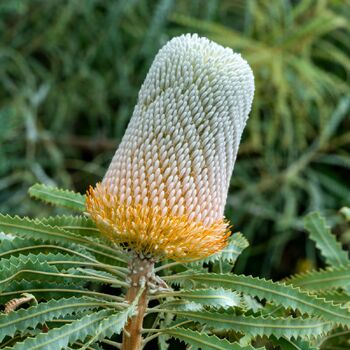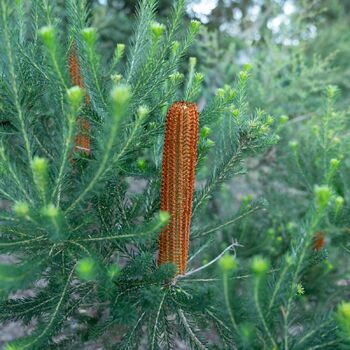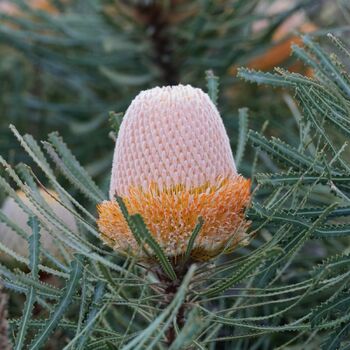
How to Grow Banksia Seeds
Grow Guide #2835
Family: Proteacea
Binomial name: Banksia sp.
Life Cycle: perennial
This 'How to Grow' guide details everything a home gardener needs to know to plant, grow and care for Banksia (Banksia sp.).
When to Sow Banksia Seeds
Banksia is a perennial plant that grows year round in most climates. Use the table below to identify the best time of year to sow banksia seeds in your climate.
| JAN | FEB | MAR | APR | MAY | JUN | JUL | AUG | SEP | OCT | NOV | DEC | |
|---|---|---|---|---|---|---|---|---|---|---|---|---|
| Cool | ||||||||||||
| Temperate | ||||||||||||
| Sub-Tropical | ||||||||||||
| Tropical | ||||||||||||
| Arid |
Preparation
Banksia plants are best grown in full sun. Choose a location that will receive at least 6 hours of full sun each day.
Banksia plants are perennial, meaning they live for several years. Choose a permanent position where plants can grow undisturbed by regular digging.
Banksia plants need a very well drained soil. In most cases there is no need to enrich soil with manure or other fertilisers. Prepare soil by weeding it thoroughly and digging it over to loosen it. Keep the area free of weeds until planting. Learn more about preparing soil for planting here.
Banksia plants can be grown in containers. If possible choose a variety that’s recommended for container growing. Use a good quality potting mix and make sure your container is large enough for mature plants; a minimum of 75 litres is recommended for banksia. During the growing season, keep in mind that container grown plants may need additional fertiliser to encourage healthy growth.
How to Sow Banksia Seeds
Banksia seeds do not require any treatment (eg soaking, stratification) before sowing.
Banksia seeds grow best when they are raised in trays or other containers and transplanted to the garden once established.
- Fill trays, punnets or jiffy pots with a good quality seed-raising mix, or use soil starter pellets.
- Sow seeds 3mm deep.
- Keep soil moist but never wet or dry.
- Seeds should germinate in around 21-40 at a soil temperature of 20-25°C.
- Transplant seedlings to the garden once they have their first true leaves and are large enough to handle (usually 5-10cm tall).
- Plant out, spacing plants 150cm apart.
Note: Seeds of many native plants are dormant and will not germinate until ideal environmental conditions are met. Follow instructions for pre-treatment and sowing, and be patient; some wild harvested seeds can take much longer to germinate than expected.
How to Grow Banksia
Banksia plants are drought tolerant once established and grow best in soil that is dry and very well drained. Let the soil dry out between watering, and only water when the soil is dry about 10cm below the surface (test this by scratching away a little soil with your finger), even in summer. Water deeply in the early morning or late afternoon. Avoid watering the leaves of plants to avoid fungal diseases. Learn more about watering here.
If soil was well prepared no extra fertiliser should be necessary. In poor soil or to give your plants an extra boost, application of a low-phosphorus fertiliser or one formulated for native plants can be beneficial:
- Apply slow release fertiliser at the recommended rate when transplanting or when seedlings are 5-10cm tall.
- Apply liquid fertiliser at the recommended rate and frequency while plants are fruiting or flowering.
Flowers can be used as cut flowers and should be harvested when about a quarter of the florets are open on each flower spike. Use sharp snips or secateurs to cut branches to the desired length, removing the lower leaves and placing the stems immediately in a clean bucket of water. Banksia flowers can also be dried by hanging branches upside down in a dry place out of direct sunlight.
When plants have finished flowering prune them back to neaten them and encourage strong new growth. Using sharp secateurs or snips, cut individual stems just above a set of lower leaves.
Banksia should reach maturity in approximately 3-10 years.
Common Problems when Growing Banksia
Like all plants, banksia is susceptible to some pests, diseases and other problems. Below is a list of the most common problems gardeners encounter when growing banksia plants:
 Grey mould (Botrytis sp.) is a fungal disease that causes flowers to become mouldy and fruit to rot. Spores are transported by wind and can survive in soil or on green waste. The fungus spreads most in cool, damp weather. Prune off affected flowers and fruit, water plants at soil level (not on leaves) and if necessary spray with an appropriate fungicide or homemade spray.
Grey mould (Botrytis sp.) is a fungal disease that causes flowers to become mouldy and fruit to rot. Spores are transported by wind and can survive in soil or on green waste. The fungus spreads most in cool, damp weather. Prune off affected flowers and fruit, water plants at soil level (not on leaves) and if necessary spray with an appropriate fungicide or homemade spray..jpg) Powdery mildew is caused by fungal spores reproducing on the leaves of plants. First showing as white spots on leaves, affected areas can spread quickly to cover the entire leaf surface. While rarely fatal, powdery mildew can reduce yields. Water plants at soil level (not on leaves) to prevent spreading spores, allow good air flow between plants, remove affected leaves and if necessary spray with an appropriate fungicide or homemade spray. Read more here about powdery mildew here.
Powdery mildew is caused by fungal spores reproducing on the leaves of plants. First showing as white spots on leaves, affected areas can spread quickly to cover the entire leaf surface. While rarely fatal, powdery mildew can reduce yields. Water plants at soil level (not on leaves) to prevent spreading spores, allow good air flow between plants, remove affected leaves and if necessary spray with an appropriate fungicide or homemade spray. Read more here about powdery mildew here. Root rot is a disease caused by soil-borne fungi found in wet soil. Plants may be slow to establish, have yellowing or wilted foliage and have soft, brown tissue around the base of the stem and roots. Root rot is often fatal; remove and dispose of affected plants. Reducing soil moisture, adding organic matter to the soil and making sure mulch doesn't touch the stems of plants may help avoid root rot.
Root rot is a disease caused by soil-borne fungi found in wet soil. Plants may be slow to establish, have yellowing or wilted foliage and have soft, brown tissue around the base of the stem and roots. Root rot is often fatal; remove and dispose of affected plants. Reducing soil moisture, adding organic matter to the soil and making sure mulch doesn't touch the stems of plants may help avoid root rot.


.png)





